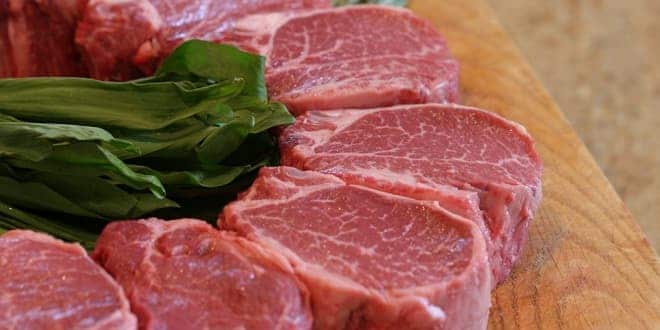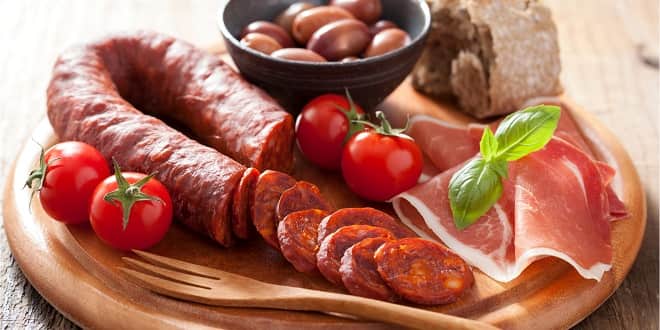Laboratory > Analysis of Meat
Purpose :
Our purpose is analysing the meat and meat products and their quality parameters which are determination of total fat content as percent value, the moisture content, pH values, and off-odour of the products from şahin( sucuk), pınar(sausage), maret(sausage), pınar(salami), and banet(sucuk).
Theory :
THE COMPOSITION OF MEAT:
Water
Water content can be decreased (e.g. dried or dehydrated meat), and it varies in many processed meats such as sausages, salamis, bacon and ham. During these processes, care must be taken to protect the nutritional and organoleptic (taste, smell, texture and appearance) properties of the meat.
Protein: Protein is the source of the essential amino acids necessary for life. It is the building block of the muscular tissue.
Fat: Fat itself consists of triglycerides (see below), and is the main energy reserve for the animal. Other important substances (e.g. some vitamins) are dissolved in this fat.
Soluble non-protein organic substances: These substances fall into two categories: nitrogen-based substances such as free amino acids and vitamins, and carbohydrates such as lactic acid and glucose.
Inorganic substances: The major minerals consist of phosphorous and potassium together with small amounts of sodium, magnesium, calcium, zinc, and other trace metals.
• Addition of reducing sugars (e.g. glucose solids, dextrose) to the brine also helps in browning reactions during thermal processing to produce a desirable colour and a caramel flavour in some products such as bacon.
• 1–2%, are added to the brine during various commercial operations in order to lower the water activity of meat during curing.
Enhancing the texture and sensory quality of high pressure treatment meat products
Although many in the food industry perceive high pressure treatment as a relatively new technology, early investigations examined the ability of high pressures to increase the shelf-life of milk treated at ambient temperatures. Since then, the effect of high pressure on micro-organisms, proteins and, more recently, in food processing has been studied. Work at The National Food Centre investigated the use of high pressure (150 MegaPascals – MPa) to enhance the functionality and acceptability of frankfurters with reduced salt and phosphate concentrations, and breakfast sausages with reduced phosphate, in an effort to address consumer demands for high quality products with fewer added ingredients.
Sodium chloride (salt) and phosphate are essential ingredients in meat processing, where they act by solubilising the myofibrillar proteins that contribute to water-holding capacity, thus reducing cook loss. These ingredients also enhance fat binding in meat products, entrapping other ingredients to form a uniform and cohesive mass. Salt also decreases water activity, which significantly extends the shelf-life of the product. However, consumption of excess sodium chloride has become a major issue in the food industry because of the relationship between sodium and hyper-tension in humans. According to the US Department of Agriculture, phosphates are safe when added within the permitted concentration of 0.5%, but such additives generate adverse reactions from the consumer.
Our research has examined high pressure to compensate for reduction in salt and/or phosphate in frankfurters and sausages. High pressure is obtained using a hydraulic pump and is applied to the products via a pressure-transferring medium. This results in uniform pressure transmission throughout the product, independent of product shape and size. Being a non-thermal process, product flavour and nutritional qualities are maintained.
Our results indicated that frankfurters treated with high pressure (150MPa) had lower cooking losses than non-pressure treated products. Emulsion stability and texture of pressurised products were as acceptable as control frankfurters. Cook yield was also enhanced when phosphate concentration was reduced to 0.1%, and texture was improved in reduced-salt frankfurters after 300MPa pressure. Pressure treated (150MPa) sausages had similar stability and overall acceptability as non-treated products and texture profile analysis was enhanced when the phosphate was reduced to 0.25% after the pressure treatment. Overall flavour intensity of breakfast sausages with 0.25% phosphate was not affected by the pressure treatment.
Although high pressure treatment is a batch process, these results are positive for the processed meat industry as a novel route to the production of additive-reduced meat products. Further investigations into minimal processing in the Meat Technology Department are concentrating on the use of high intensity ultrasound as a rapid, energy efficient technique to cook pressurised meat products.
RESULT & CALCILATIONS OF THE EXPERIMENT:
Group name | Fatcontent% | Off-odor | Moisture content% | pH |
A1-ŞahinSucuk | 32,46 | + | 45.7 | 6.5 |
A2-no markSucuk | | + | 30.08 | 5.04 |
A4-pınarSausage | 11.02 | – | 66.33 | 5.6 |
A5- maretSausage | | – | 38 | 6.20 |
A6-no markSucuk | | – | 66.1 | 6.4 |
A7- pınarSalami | | – | 68 | 5.65 |
A9- banetSucuk | | – | 54.7 | 6.03 |
Calculation
Fat content:
Weight of empty flask= 117.88 gr
Weight of the sample =20.14 gr
Weight of the fat=2.22 gr
Weight of the fat and sample= 120.1gr
Moisture content:
Weight of the sample= 5.02 gr
Weight of the petri = 50.18 gr
Weight of samle and plate after drying= 51.87 gr
Weight of the sample and plate= 50.18+5.02= 55.2 gr
Ph value:
Ph of the sausages:5.6
Off odor test:
There is no off odor smelt.
TSE VALUES FOR SAUSAGE:
Components | Limits |
Moisture (mass)Salt (mass)Total animal fatsPotassium or sodium nitratePotassium or sodium nitriteStarchColor and flavorBad flavot testpHColoring matter | Max. 65% |
Max. 3% | |
Min. 15% | |
Max. 500 mg/kg | |
Max. 200 mg/kg | |
Max. 5% | |
Appropriate | |
Negative | |
Max. 6.3 | |
No |
TSE VALUES FOR SOUDJUCK:
Components | Limits |
Moisture(mass)Salt(mass)Coloring matterpHfat(mass)for first qualityfor secand qualityfor third qualityprotein(mass) N*6.25for first qualityfor secand qualityfor third quality | Max. 40% |
Max. 5% | |
None | |
Max. 5.8 Min. 5.4 | |
| | |
Max. 30% | |
Max. 40% | |
Max. 50% | |
| | |
Max. 22% | |
Max. 20% | |
Max. 20% |



